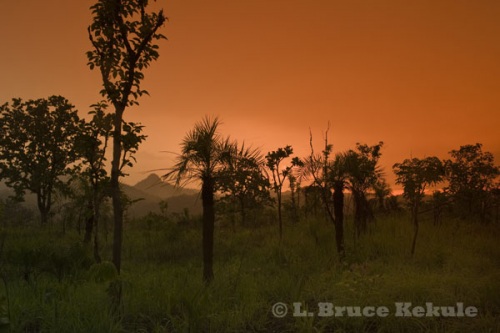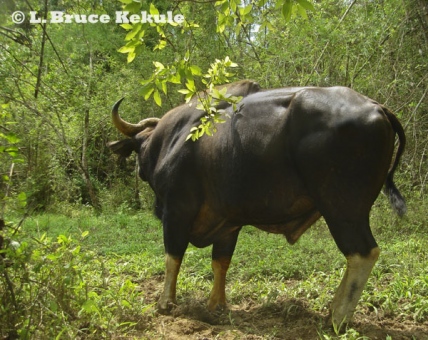Jewel in The Kingdom – Part One
Thung Yai Naresuan Wildlife Sanctuary:
Thailand’s largest protected area and World Heritage Site: A look at present-day Thung Yai
Thung Yai Naresuan Wildlife Sanctuary established in 1974 is the single largest protected area in Thailand encompassing 3,647 square kilometers. Named after King Naresuan the Great who repelled Burmese invaders back in the 16th century gaining independence for the Thai nation. The sanctuary is not only historically famous but one of the Kingdom’s greatest natural wonders.
Sunset over the grassland in Thung Yai
Due to its size, the sanctuary is divided into two separate administrative blocks – east and west for easier management, and each with its own superintendant. The most important part of this great place is the grassland or savannah in the middle of the western section. The sanctuary gained this status due to the biodiversity of its flora and fauna, and the absolute need to save this vast area from further human destruction.
Cycad on the savannah
Thung Yai is a UNESCO World Heritage Site (established in 1991) along with Huai Kha Khaeng Wildlife Sanctuary to the east. Adjoining Thung Yai in the south is the Sri Nakharin, Khao Laem and Lam Klong Ngu national parks, and Umphang Wildlife Sanctuary to the north. This cluster is part of the Western Forest Complex that comprises of 18 protected areas under the responsibility of the Department of National Parks, Wildlife and Plant Conservation (DNP).
Bamboo by the road in Thung Yai
After many months of planning, a trip with my team to Thung Yai (west) situated in Kanchanaburi province on Thailand’s western border with Myanmar was undertaken. We entered the sanctuary on May 1st at Ti Nuay, the present day headquarters area. I was interested to see how this important wildlife sanctuary was coping in the present day, and to observe the impact of humans on its fragile ecosystems. Unfortunately the protected area has a history of ill-fated exploits.
On May 1, 1973 a military helicopter coming from Thung Yai crashed in Nakhon Pathom rice fields northwest of Bangkok. The son of the pilot was killed on impact. Trophy heads, antlers and elephant ivory including weapons were splayed all over the crash site. It made big news and led to the fall of Field Marshal’s Thanom Kittikachorn and Praphas Charusathien’s regime.
The implications of this scandal were serious. In the group were high-ranking government officials, army and police plus movie stars and big business men. Personnel and equipment were provided by the army including a helicopter, GMC trucks, jeeps and local guides hired out by the organizers. It was suppose to be a ‘safari’ for the rich on Thailand’s largest savannah after large wild trophy animals.
Gaur bull camera trapped in a mineral lick
One story floated out that gaur and elephants had been slaughtered in the grassland using the door guns on the Huey helicopter. Other stories like nightly spotlighting and large mammals left to rot in the forest while wild deer meat was served during parties that went on into the night. All the officials on board the disastrous crash were transferred to in-active posts. It certainly made a dent on wildlife conservation and the long-term plight of the sanctuary. However, this prompted the Royal Forest Department (RFD) to gazette Thung Yai as a protected area the following year.
Prior to the crash, mining companies in Bangkok gained mineral concessions in several areas around Thung Yai to mine lead-zinc and other associated minerals like silver, palladium and antimony to name a few. The concessionaires cut a road right through the heart of Thung Yai from the town of Klity northeast of Thong Pha Phum. The dirt and rocky road snakes all the way to the Burmese border and then carries on into Burma for about 10 kilometres before looping back into Thailand. The thoroughfare then continues on to the town of Sangklaburi (Three Pagoda Pass) and is used by local villagers. In the past, big 10-wheel mining trucks with straight exhaust pipes screamed through Thung Yai during the dry season causing extreme noise pollution and disturbing the wildlife.
Gaur cow camera trapped at a mineral lick
A group of mines situated along the sanctuary’s border include Phu Jue, Phu Mong and Kao Lee mines. On the southern side are the Klity, Bo Ngam, and KEMCO (or Song Thor) mines plus a number of other small-scale operations, all with lead separation plants.
These lead mines are killing ethnic communities and contaminating water sources here. Several Karen villagers particularly at Lower Klity village have already died from lead contamination while many dozens of people particularly women and children are suffering from acute lead poisoning by drinking, fishing and washing in the Klity stream near the village.
More than 100 cattle have died and the villagers cannot drink from the waterway because it makes them ill. Some forest rangers in Thung Yai believe that wildlife is also suffering as they have seen deer and other animals dying in the same way as the cattle.
Red-whiskered bulbul
The Pollution Control Department investigated the area and found the amount of lead in sediment in Klity stream below the mine is 165,720 to 552,380 ppm (parts per million). Thailand’s safety standard is 200 ppm. A subsequent investigation by the department revealed the mine failed to treat its wastewater and illegally dumped it into the stream.
The mines have been operating for more than 40 years by influential people with connections to local officials and a political party. Although the lead mines are located just outside Thung Yai Naresuan Sanctuary, the effects of contamination from toxic discharge is spreading far beyond the mine concession areas.
In July 2006, the Natural Resource and Environment Minister Youngyuth Tiyapairat said the RFD reported that the permit for the mining firm to use the land in the forest was about expire (2007) while the Director General Damrong Pidej of the National Parks, Wildlife and Plant Conservation Department would not allow the company to go into the forest either. Damrong also said operations at the mine, which is located in a 70,000-rai forest just past the Karen village of Jagae, has been stopped for almost a decade but the mining company now wants to re-open it and is fighting with the court to resume operations.
Mr Damrong said he would use environment-related laws to bar mining of all kinds of minerals in the wildlife sanctuary especially since it is a World Heritage Site. He called on other agencies concerned, including the RFD and the Department of Minerals to stop granting mining concessions in forested areas.
Mr Yongyuth also ordered forest officials to tightly guard the area to prevent the transport of mining equipment in or out of Thung Yai. He also pushed legislation through parliament to help the rangers improve their standard and grade, and today, more than 50 percent of the DNP’s staff is now permanent hire, a big improvement over the old days when 90 percent were temporary hire.
Mae Nam Choan river
The sanctuary has many rivers and streams. These include the Mae Khlong (Upper Khwae Yai), Suriya, Dongwee, Songthai, Tsesawoh and Maekasa, plus other smaller tributaries. The Mae Khlong River begins its long journey in Umphang Wildlife Sanctuary in the western part of Tak province near the border with Burma. The Mae Chan River, another major tributary, merges with the Mae Khlong in Thung Yai. From there, this waterway, known as Mae Nam Choan or the Upper Khwae Yai River, is steep, swift and rocky. It eventually flows into the Sri Nakharin reservoir which inundated 418 square kilometers to the south of the Thung Yai. The Sri Nakharin Dam in Kanchanaburi was built to harness this powerful river and provide power and water to people on the lowlands.








